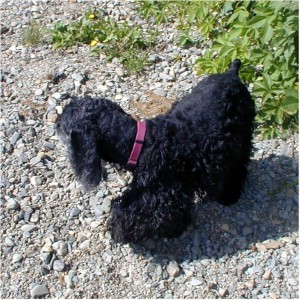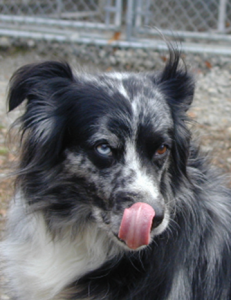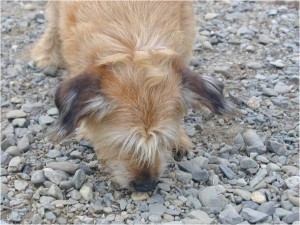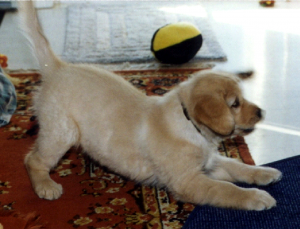< You may download and print a copy of this article by clicking this link >
< Updated 10MAY19 >
Dog parks can be an excellent place for your dog to run, romp, and socialize.

They can provide an outlet for much needed mental stimulation and physical exercise, especially if you do not have a fenced yard where your dog can do this at home. However, as I will explain in this article, dog parks can also be the site of great tragedy. I cannot emphasize enough, the need for caution before you take your dog to the dog park.
What Do the Experts Say About Dog Parks?
 In a March 14, 2018 blog post by Nancy Kerns, the editor of The Whole Dog Journal, Dog Parks Are Dangerous! , Kerns describes what she calls “…a completely avoidable dog park fatality.” The news report by KCRA-3 in Sacramento shows video of Honey at the dog park the day before she was killed and describes what happened. The dogs who killed Honey in this incident are dangerous dogs and should never have been allowed off-leash outside of a fenced yard at their home again, much less be allowed at a dog park, yet what will prevent that from happening?
In a March 14, 2018 blog post by Nancy Kerns, the editor of The Whole Dog Journal, Dog Parks Are Dangerous! , Kerns describes what she calls “…a completely avoidable dog park fatality.” The news report by KCRA-3 in Sacramento shows video of Honey at the dog park the day before she was killed and describes what happened. The dogs who killed Honey in this incident are dangerous dogs and should never have been allowed off-leash outside of a fenced yard at their home again, much less be allowed at a dog park, yet what will prevent that from happening?
Kerns is not alone in her cautious approach to dog parks. In April of 2013, Dr. Karen London’s article Culture of Dog Parks appeared in The Bark, where she wrote: “It’s hard to deny the cliché that dog parks create both the best of times and the worst of times.“
In the January 2018 issue of The Whole Dog Journal, professional dog trainer and author, Pat Miller, outlined the pros and cons of dog parks in an article of the same name. Miller notes “As dog parks have become more common (and, indeed, as dog ownership has been on the rise in the past decade) they have somehow morphed from being something that local dog owners band together and fight to build, to places where few really knowledgeable owners care to take their dogs. It seems everyone has a horror story to tell about “that day at the dog park,” featuring overstimulated dogs running amok, dogs practicing bully behaviors, dog fights, and even dog deaths.” [Emphasis added]
In a blog post from May 10th, 2019 entitled Dogs That Should Avoid Going to a Dog Park, veterinarian Dr. Karen Becker discusses why some dogs should avoid dog parks.
I love dogs and like nothing better than helping people and their dogs have the best life possible. I do not believe anyone intentionally puts their dog in harm’s way. However, in today’s fast-paced life where we often seem to jump from one task to the next with little forethought, we can put our dogs at risk. There are many things to consider before you take your dog to the dog park. As I discuss the pros and cons of dog parks, I will provide you with suggestions on what you can do to make sure that if you choose to take your dog to a dog park, it is a pleasurable experience for all.
Questions to Ask Yourself Before the 1st Trip to A Dog Park
Assessing Your Dog

How long have you had your dog? If you have just rescued a dog, congratulations and thank you for providing a home to a dog in need! However, you need to understand that going through the rescue process can be pretty traumatic, and as a result, you may not know your dog’s true nature for several days or even weeks. To ensure your dogs transition from rescue to companion goes as smoothly as possible, take some time to get to know your new friend. Build an incredible bond before you tackle an adventure, with significant risks, like the dog park. The same holds true for starting a training class, and yes you should complete a training class with EVERY dog in your family; however, not all rescues will be ready to start a class immediately, as I learned with my rescue dog Muppy.
However, if you have a puppy, you need to recognize that a critical learning period for a puppy starts at eight weeks of age and ends by sixteen weeks of age. You will want to start them in a class during this timeframe or at least be working with a reward-based, fear-free trainer at this time.
How old is your dog?
- Puppies – For health reasons alone I would NEVER bring a puppy to a dog
 park until they are fully vaccinated. Remember, unlike a reputable puppy headstart class or daycare, no one is verifying that dogs visiting the dog park are current on all recommended vaccinations and are free of worms fleas, and other parasites.
park until they are fully vaccinated. Remember, unlike a reputable puppy headstart class or daycare, no one is verifying that dogs visiting the dog park are current on all recommended vaccinations and are free of worms fleas, and other parasites. - Puppies first learn about interacting with other dogs and how and how not to play from littermates, mom, and hopefully from other appropriate older dogs. A singleton puppy, or puppies that are removed from mom too soon, may miss out on many essential learning opportunities and may not be appropriate for the dog park. If you adopt a puppy that falls into this category, I recommend working with a reward-based, force-free trainer without delay.
- While it is essential for a puppy to have opportunities to play and interact with other dogs, especially during the 8 to 16 week socialization period, it is vital that you plan and control those playtimes to ensure a positive outcome. That means you need to know the people and the other puppy that will be playing with your pup.
- The best playmates for a puppy are those of the same approximate age and size that also enjoy the same type of play. Some puppies like to chase while others like to be chased. Some want to body slam, while others prefer to wrestle. Puppies with mismatched play styles may not have a good time.
- I also advise my puppy headstart students to avoid letting their pup play with “teenage” dogs between 12 months and 36 months of age unless they know those dogs very well. Doing so is not all that different from sending a five-year-old child out with a group of teenagers. Yes, a young puppy may happily interact by playing with canine teenagers, but they may also learn to play too rough and in a manner that will not be appreciated by pups in their age group.
- Lastly, the best play opportunities for a new puppy is with one other puppy at a time. By limiting a playgroup to two puppies, you avoid the possibility of a group of pups bullying one puppy. Two dogs are also much easier to supervise than several puppies. Yes, daycare’s will have more dogs playing at once; however, any reputable daycare staff will have several hours of training on behavior and group play before being asked to supervise a group of dogs. Even then a trustworthy daycare will limit the size of playgroups to no more than five to eight dogs per supervising pet care technician.
- Senior Dogs – An older dogs view of enjoyable play may be very different
 from the type of play preferred by puppies or adolescent dogs. Many older dogs prefer just wandering, sniffing, and exploring their surroundings. They avoid interactions with younger, overly enthused dogs that often play too rough. If your senior dog is in this category, the dog park may not be a good choice. An older dog can wander and enjoy themselves on a long line many places where they do not need to concern themselves with rowdy dogs.
from the type of play preferred by puppies or adolescent dogs. Many older dogs prefer just wandering, sniffing, and exploring their surroundings. They avoid interactions with younger, overly enthused dogs that often play too rough. If your senior dog is in this category, the dog park may not be a good choice. An older dog can wander and enjoy themselves on a long line many places where they do not need to concern themselves with rowdy dogs. - Has your new puppy or dog been examined by your veterinarian? – Before taking a dog to the dog park, you need to take them to your
 veterinarian for their first wellness exam, even if the shelter or breeder just had the dog at their veterinarian. Your veterinarian will make sure that your dog gets all of the necessary vaccines or titer tests before they are exposed to the world. Your veterinarian will also discuss flea and parasite preventatives. This is important because no one is verifying that other dogs at the dog park have been vaccinated and are free of parasites. You do not want to take your dog to the dog park and have them bring home any unwanted and potentially harmful parasites, bacteria or viruses.
veterinarian for their first wellness exam, even if the shelter or breeder just had the dog at their veterinarian. Your veterinarian will make sure that your dog gets all of the necessary vaccines or titer tests before they are exposed to the world. Your veterinarian will also discuss flea and parasite preventatives. This is important because no one is verifying that other dogs at the dog park have been vaccinated and are free of parasites. You do not want to take your dog to the dog park and have them bring home any unwanted and potentially harmful parasites, bacteria or viruses. - If your new friend has not been spayed or neutered yet, this is also when your veterinarian will discuss the pros and cons of neutering and the appropriate time for doing so. Spaying and neutering is not a black and white topic as it once was. You may want to get more than one opinion about whether you should spay or neuter, and when you should do so. Do not let a breeder or veterinarian dictate what you decide. When it comes to dog parks, understand that an unspayed female should not be at a dog park or daycare at any point during her heat cycle, and unneutered males may not always play appropriately. Many boarding and daycare facilities will require that dogs be spayed/neutered by six months of age if they participate in group play.
- How well was your dog socialized between three and sixteen weeks of age? Puppies have a critical socialization period between three and sixteen weeks of age. If you have a rescue dog, it is unlikely you will know how your dog was socialized, and it is a pretty safe bet that they had little or no socialization. That means that it is very likely that they will be cautious and possibly fearful of anything or anyone that they have not experienced previously. I would NOT recommend taking a dog to the dog park as a way of making up for a lack of socialization during the critical period. Also, recognize that socialization is about much more than introducing your dog to a couple of other dogs. Dogs vary widely in appearance and behavior, so it is essential that your dog have positive experiences with dogs of a wide variety of shapes, sizes, ages, colors and play styles. While remedial socialization is possible, it must be planned and controlled, and one must proceed slowly. Under socialized or inappropriately socialized dogs are not a good candidate to go to the dog park until they are no longer anxious in novel situations. Habituating your dog to novel stimuli may take several weeks of effort on your part. A reward-based, force-free trainer can help you plan a socialization program for your dog and can help make sure that you minimize any mistakes.
- Is your dog anxious, fearful, reactive, or aggressive towards dogs or people? If, yes, do NOT take your dog to the dog park. There are many
 reasons your dog may behave in this manner. Taking them to the dog park is unlikely to change your dog’s behavior and in fact, has a high probability of making this behavior worse because the dog park will be filled with the things that cause your dog to react; people and other dogs. It also puts other people and dogs at risk of a severe
reasons your dog may behave in this manner. Taking them to the dog park is unlikely to change your dog’s behavior and in fact, has a high probability of making this behavior worse because the dog park will be filled with the things that cause your dog to react; people and other dogs. It also puts other people and dogs at risk of a severe
- How well trained is your dog? To keep your dog, yourself, and others at the dog park safe, you have a responsibility to maintain control over your dog at all times and in all situations. Minimally, your dog should have a reliable sit, recall, an attention/look behavior, and a leave-it Your dog should reliably respond to these cues in your home and in the presence of other dogs and people in novel environments. If you and your dog have not become proficient at these behaviors, or if your dog is distracted by other dogs, enroll yourself and your dog in a reward-based training program that does not use aversives. You will be ready for the dog park once your dog responds reliably to behavioral cues in the presence of other dogs and people.
- The sit behavior is useful for getting your dog under control, helping the

Muppy Recall dog to learn to control their impulses and a way you can prevent them from jumping on other people and dogs at the dog park.
- A reliable recall behavior will allow you to get your dog to return to you instead of joining a dogfight or may prevent them from mobbing the new dog entering the park.
- A well-trained leave-it can work in much the same fashion.
- After you have accomplished teaching these behaviors, then take your dog to the dog park.
- The sit behavior is useful for getting your dog under control, helping the
- Why are you taking your dog to the dog park? Not every dog needs to go to

Dulcie with her addiction the dog park or for that matter doggie daycare. One of the new myths being perpetuated by some is the idea that you are a bad dog parent unless you take your dog to daycare or the dog park several days per week. The fact is, not all dogs will benefit from or enjoy dog parks or doggie daycare. We rescued our Cairn Terrier Dulcie when she was about five years old. We let her settle in our home, and a few weeks later I sent her to daycare. I owned the daycare, it was easy, and I thought she would enjoy socializing with other dogs. Within a couple of days, my staff was telling me “Dulcie hates daycare. She has no interest in the other dogs and wants them to stay far away.” That ended Dulcie’s daycare adventure and also let me know that Dulcie would have hated a dog park.
If your dog loves a rousing game of fetch, it is entirely possible that they will not enjoy other dogs chasing after their “ball.” There are many places to play fetch other than the dog park.
If your dog only needs a place to sniff or roll in the grass, fence in your  yard or if that is not an option, put your dog on a long line (a 15 to 20-foot leash) and let them explore your yard or non-dog parks where dogs are allowed.
yard or if that is not an option, put your dog on a long line (a 15 to 20-foot leash) and let them explore your yard or non-dog parks where dogs are allowed.
Daycare and dog parks are for well-socialized dogs that already enjoy the company of other dogs and people.
Neither the dog park nor daycare is an appropriate venue for the remedial socialization of a dog that is anxious or reactive to other dogs or people.
- If your dog enjoys the dog park, please do not overdo Stress comes in two forms; distress when something bad happens to us and eustress when something good happens to us. Both have the same physiological effect on the body and when chronic can be very detrimental. A trip to the dog park every 3 or 4 days will be more than enough for most dogs.
Assessing Yourself
- Do you have a basic understanding of dog behavior? Many of the myths about dogs, such as; dominance and being “alpha,” and the need to use aversives to exert dominance are not only false but are counterproductive to the training, management, and care of a dog. They can easily cause a dog to become unsuitable for interactions at the dog park. If you need help in understanding what is fact and what is myth about canine behavior, seek out a professional rewarded-based, fear-free dog trainer. Do NOT rely on the internet which is where many of the erroneous information about dog behavior is routinely circulated.
- Do you understand the subtlety of body language used by dogs? Dog’s use
 their body to communicate with other dogs as well as us. A dog may give many signals before they react, giving us an opportunity to help them before things get out of hand. You need to be able to recognize your dog’s calls for help. A professional force-free and pain-free dog trainer can teach you how to interpret what your dog is trying to tell you.
their body to communicate with other dogs as well as us. A dog may give many signals before they react, giving us an opportunity to help them before things get out of hand. You need to be able to recognize your dog’s calls for help. A professional force-free and pain-free dog trainer can teach you how to interpret what your dog is trying to tell you.
How well do you understand dog play behavior? Most dogs love to play,  and it is an essential part of their ongoing development. However, no dog will play if they are thirsty, hungry, tired, in pain or fearful. Dogs need to feel both physically and emotionally safe before they will play. A dog that is new to you, especially a rescue, is unlikely to feel safe in your home immediately, much less at a dog park filled with strangers. Until you have established a bond of trust with your dog, you are better off avoiding the dog park. When you do decide to visit the dog park, be ready to leave if your dog is not having a good time.
and it is an essential part of their ongoing development. However, no dog will play if they are thirsty, hungry, tired, in pain or fearful. Dogs need to feel both physically and emotionally safe before they will play. A dog that is new to you, especially a rescue, is unlikely to feel safe in your home immediately, much less at a dog park filled with strangers. Until you have established a bond of trust with your dog, you are better off avoiding the dog park. When you do decide to visit the dog park, be ready to leave if your dog is not having a good time.
Play has no other aim but itself, it is all about fun. Normal dog play includes bits and pieces of aggressive, predatory, and sexual behavior in a non-threatening context. Once a dog is playing it usually is all about play. Keep the dog park for play and other places for training. A visit to the dog park can be a high-value reward after a brief training session.
Play is ALWAYS voluntary. First of all, it is NOT play if any of the participants are not interested in playing. When a dog initiates play, it is normal to respect others dog when they tell them “not now.” Not all dogs do well at this. When my dog Tikken was a puppy, she was not good at listening to older dogs who asked that she back off.
Play is self-rewarding. Just like some people get a “runners high” and others get addicted to gambling, chocolate, nicotine, and narcotics some dogs can get addicted to playing, which is not a good thing. The same thing that happens in the brain of a runner or drug addict can happen in the brain of a dog. Fetch, which is predatory behavior, is self-rewarding, and with some dogs can become a compulsive behavior. Our dog Dulcie was a ball addict. When people did not “give Dulcie “a tennis ball fix,” she became cranky and chronically stressed. Chronic stress can cause numerous emotional, mental and physical health issues. Dogs can also get addicted to the dog park, so remember, visit in moderation. I discourage daily visits to the dog park.
Play is not the same as reality. While play is very real, it is a variation on normal behaviors such as aggression, predation, and sex. That is why dogs will typically signal play via a play bow. The play bow means that what the dog does following the play bow and is NOT aggression or predation. Be aware that the play bow can also be used as a calming signal to increase distance. A play bow requesting play will be very dynamic with fluid and quick lateral motions. A play bow in slow motion is a way of saying “take it down a notch.”
Play is flexible and variable. Dogs will find a variety of ways to play. If it is with an object, play might constitute mouthing it, tossing it around, or pushing it with their nose. If it is play with another dog they might wrestle, chase, lie down and chew next to each other, then do some more chasing. Play is variable to keep it fun.
Play includes role reversals; there are no winners. Appropriate play between two dogs should be balanced. Dog A chases Dog B; then Dog B. chases Dog A, etc.. Dog B is on top when wrestling than Dog A gets their turn on top. If play is one-sided, it is no longer play.
Play includes self-handicapping. Older and larger dogs will often self-handicap when playing with smaller and younger dogs. We used to have an English Mastiff daycare with us, and she was one of the best dogs at getting puppies to play because she was so gentle and good at self-handicapping.
- How reliable are your dogs sit, leave it, and recall behaviors? You have a

Muppy Recall responsibility to be able to control your dog when they are out in public. Lack of training becomes even more critical at a dog park. If your dog cannot reliably perform a; SIT, LEAVE IT, or RECALL in the presence of other dogs, they are not a good candidate to take to the dog park. A professional, reward-based, force-free trainer can help you teach your dog these behaviors.
- Do you know how to break-up a dogfight? If you are at all worried about
 your dog getting into a fight, do not go to the dog park. If you scout out the dog park before you bring your dog there, you should minimize the chances of a fight if the dog park passes my recommended tests. Dr. Sophia Yin has written an excellent article on breaking up a dog fight which you can access by clicking the link found above.
your dog getting into a fight, do not go to the dog park. If you scout out the dog park before you bring your dog there, you should minimize the chances of a fight if the dog park passes my recommended tests. Dr. Sophia Yin has written an excellent article on breaking up a dog fight which you can access by clicking the link found above.
For Your First Visit – Leave Your Dog At Home
I recommend that you visit the dog park without your dog until you can first assess the physical facility and the parks culture. Visit the dog park without your dog on a day and at a time when you are likely to visit, looking for the following:
Assessing the Dog Park
- Does the park have a double-gated entrance? – A double-gated entrance is
 a basic safety feature for a dog park. By opening only one gate at a time, it is possible to limit the possibility of dogs escaping. If there is no double gate, find another dog park
a basic safety feature for a dog park. By opening only one gate at a time, it is possible to limit the possibility of dogs escaping. If there is no double gate, find another dog park - Is there a separate area for smaller dogs? – There is a huge difference in mass between a 4lb Yorkie and a 250lb English Mastiff. Even with no malicious intent, a larger dog can seriously injure a small dog during play. If you have a small dog, 30lb and less, you need a separate area at the dog park. Moreover, just because your little dog thinks they are a big dog, is no reason to allow them to play in the big dog area.
- How large is the dog park and where is it located? – Ideally, a dog park will be several acres in size. Sadly, dog parks are often low priorities for many
 municipalities and are typically too small. Ten dogs in some dog parks at the same time may be too many. Dog parks are often located on the outskirts of town or in a less than desirable neighborhood, so think about your safety as well. My favorite dog park is Bruce Pit in Ottawa, Ontario. I had the opportunity to tour Bruce Pitt with my friend Carolyn Clark and Turid Rugaas, the author of Calming Signals. The park is enormous with varied terrain for the dogs to explore. It is possible to for your dog and a canine buddy to interact there without encountering a horde of frenetic fur balls.
municipalities and are typically too small. Ten dogs in some dog parks at the same time may be too many. Dog parks are often located on the outskirts of town or in a less than desirable neighborhood, so think about your safety as well. My favorite dog park is Bruce Pit in Ottawa, Ontario. I had the opportunity to tour Bruce Pitt with my friend Carolyn Clark and Turid Rugaas, the author of Calming Signals. The park is enormous with varied terrain for the dogs to explore. It is possible to for your dog and a canine buddy to interact there without encountering a horde of frenetic fur balls. - Is the fencing in good repair so that a dog cannot hurt themselves or escape? – I own a kennel with lots of fencing and can tell you unequivocally it requires constant maintenance, especially after a Maine winter. Sadly, the dog park is often the last on the priority list for many municipal park departments. If the fencing is in disrepair, find another dog park.
- Is the grass mowed on a regular basis and are the weeds under control?
 Like it or not, ticks are now part of our lives in Maine. Ticks love long grass. Recognize that if the grass at the dog park, both inside the fence and along the outside border of the fence, is not mowed on a regular basis, you may be exposing your dog and yourself to ticks and the many diseases they carry.
Like it or not, ticks are now part of our lives in Maine. Ticks love long grass. Recognize that if the grass at the dog park, both inside the fence and along the outside border of the fence, is not mowed on a regular basis, you may be exposing your dog and yourself to ticks and the many diseases they carry. - Is the park equipped to handle dog feces? – Any dog park needs to have; a dispenser for bags you
 can use to dispose of your dog’s poop and a closed container to be used for the disposal of filled poop bags and other trash. If the trash can is full, it is not getting emptied often enough. Dog feces will attract rodents, which in turn can spread parasites throughout the park. Walk around the park and observe if it is clear of feces. If not, this sadly suggests those using the park are not being good stewards and that you will want to find another dog park.
can use to dispose of your dog’s poop and a closed container to be used for the disposal of filled poop bags and other trash. If the trash can is full, it is not getting emptied often enough. Dog feces will attract rodents, which in turn can spread parasites throughout the park. Walk around the park and observe if it is clear of feces. If not, this sadly suggests those using the park are not being good stewards and that you will want to find another dog park.
Assessing the Dog Park’s Culture
- Are people focused and monitoring their dogs? Dogs at play need to be
 supervised, and you cannot be wrapped up in conversations with other people or engrossed in a cell phone and still be responsibly monitoring your dog. The best dog parks will not have places for people to sit. If people are not supervising their dogs, you want to pick a different time, day, or dog park.
supervised, and you cannot be wrapped up in conversations with other people or engrossed in a cell phone and still be responsibly monitoring your dog. The best dog parks will not have places for people to sit. If people are not supervising their dogs, you want to pick a different time, day, or dog park. - How many dogs are present and is there one person for each dog? Dog Walkers and Pet Sitters sometimes bring groups of dogs that they are caring for to dog parks because they do not have their own People with multiple dogs may also bring more than one dog to the dog park. I believe that there should be one responsible adult human per every dog at the dog park.
- How do the dogs in the park greet newcomers? Are they under control? When entering a dog park, a person and their dog are often swarmed by
 other dogs at the park. While the dogs charging to greet your dog may not have any malicious intent, your dog may not see it that way. If other people at the dog park are acting responsibly, they will call their dog to them and keep it under control so that you and your dog can enter the dog park in peace.
other dogs at the park. While the dogs charging to greet your dog may not have any malicious intent, your dog may not see it that way. If other people at the dog park are acting responsibly, they will call their dog to them and keep it under control so that you and your dog can enter the dog park in peace. - Are any of the dogs at the park bullying other dogs? If another dog is
 behaving pushy towards your dog, your dog will probably find the dog park a less than enjoyable experience. The dog that is being the bully is learning that type of behavior is okay, which means they are more likely to practice it more often. The dog park needs to be a bully-free zone.
behaving pushy towards your dog, your dog will probably find the dog park a less than enjoyable experience. The dog that is being the bully is learning that type of behavior is okay, which means they are more likely to practice it more often. The dog park needs to be a bully-free zone. - Are any of the dogs wearing shock, choke, or prong collars? Aversives
 (choke collars, prong collars, shock collars, and more) have no place in the training or management of any dog and are likely to cause fear and aggression; neither trait makes for a good dog park dog. Both the American Animal Hospital Association (AAHA) and the Pet Professional Guild (PPG) recommend that aversives should never be used.
(choke collars, prong collars, shock collars, and more) have no place in the training or management of any dog and are likely to cause fear and aggression; neither trait makes for a good dog park dog. Both the American Animal Hospital Association (AAHA) and the Pet Professional Guild (PPG) recommend that aversives should never be used.
So Let’s Go to the Park!
If you believe you and your dog are ready for the dog park and have found a park that meets your criteria for safety, then by all means go. Listed below are items I suggest you take with you whenever you visit a dog park with your dog.
Things to Bring When You Go to the Dog Park
- An extra leash
- Water and a bowl
- A first aid kit
- Poop bags
- A cell phone pre-programmed with the number of the closest vet, but keep it in the car
- Your insurance information and a pen and paper to record information
Things to Leave at Home or in the Car When You go to the Dog Park
- Your cell phone
- Your iPad or any type of electronic tablet
- Books
- Anything that will distract you from supervising your dog
Recommended Resources
Articles on Don’s Blog ( http://www.words-woofs-meows.com )
Going to the Dog Park – Is It A Good Idea for You and Your Dog? – http://bit.ly/GoingToTheDogPark
Shared Blog Post – Dogs That Should Avoid Going to a Dog Park from Dr. Karen Becker – http://bit.ly/DogParksBecker10MAY19
Things I Wish I Had Known Before I Started Training Dogs – Gus, the Dominance Myth, An Alpha Roll, and a Damaged Relationship – WWM-SEP2018 – http://bit.ly/Things-Gus-Dominance
Things I Wish I Had Known Before I Selected My First Dog – Aversives are Unnecessary and Counter-Productive When Training A Dog – Part 1 – WWM-JAN2019 – http://bit.ly/Things-Aversives-1
Things I Wish I Had Known Before I Selected My First Dog – Aversives are Unnecessary and Counter-Productive When Training A Dog – Part 2 – WWM-FEB2019 – http://bit.ly/Things-Aversives-2
Dangerous Dogs! – What Shelters, Rescues, Prospective Adopters, and Owners Need to Know – http://bit.ly/Dangerous-Dogs
A Rescue Dogs Perspective – http://bit.ly/Rescue-Muppy
How to Choose A Dog Trainer – http://bit.ly/HowToChooseADogTrainer
Puppy Socialization and Habituation – http://bit.ly/SocializationPuppy
Help! My Dog is Aggressive, Reactive, Fearful, Anxious, etc. – What do I do? – http://bit.ly/HelpDogAggx
Understanding, Identifying and Coping with Canine Stress – http://bit.ly/Canine-Stress
Pet Behavior as an Essential Component to Holistic Wellness – http://bit.ly/PetBhxWellness
Reward Based Training versus Aversives – http://bit.ly/RewardVSAversive
Dominance Reality or Myth – http://bit.ly/Dominance-RealityorMyth
Reward Based Training versus Aversives – http://bit.ly/RewardVSAversive
How Can I Tell When My Dog Is Anxious or Fearful? – http://bit.ly/DogsSignsofFear
Can You Trust What You Read on the Internet? – http://bit.ly/CanYouTrustTheInternet
Gail Fisher’s Dog Tracks: Small dogs at risk if ‘predatory drift’ kicks in – http://blog.greenacreskennel.com/2018/04/30/shared-article-gail-fishers-dog-tracks-small-dogs-at-risk-if-predatory-drift-kicks-in/
Podcasts from The Woof Meow Show ( http://www.woofmeowshow.com )
Going to the Dog Park – Is It A Good Idea for You and Your Dog? – http://bit.ly/WfMwGoingToTheDogPark
Podcast – Canine Behavior: Myths and Facts – http://blog.greenacreskennel.com/2016/03/27/podcast-canine-behavior-myths-and-facts/
Podcast – Pet Behavior, Vets & The AAHA Canine and Feline Behavior Management Guidelines with Dr. Dave Cloutier from Veazie Veterinary Clinic – http://blog.greenacreskennel.com/2016/03/13/podcast-the-woof-meow-show-pet-behavior-vets-the-aaha-canine-and-feline-behavior-management-guidelines-with-dr-dave-cloutier-from-veazie-veterinary-clinic/
Podcast – Worms, Fleas, and Ticks, Oh My!-Parasites & Your Pets with Dr. Dave Cloutier – Veazie Veterinary Clinic – http://blog.greenacreskennel.com/2016/04/24/podcast-worms-fleas-and-ticks-oh-my-parasites-your-pets-with-dr-dave-cloutier-veazie-veterinary-clinic/
Podcast – The Importance of Spaying and Neutering with Dr. Katie Carter of the River Road Veterinary Hospital – http://blog.greenacreskennel.com/2018/02/03/podcast-the-importance-of-spaying-and-neutering-with-dr-katie-carter-of-the-river-road-veterinary-hospital/
Podcast – Spaying and Neutering with Dr. David Cloutier from Veazie Veterinary Clinic ( May 2017 ) – http://blog.greenacreskennel.com/2017/05/01/podcast-spaying-and-neutering-with-dr-david-cloutier-from-veazie-veterinary-clinic/
Podcast – Considerations When Spaying and Neutering Pets with Dr. Mark Hanks from Kindred Spirits Veterinary Clinic ( February 2016 ) – http://blog.greenacreskennel.com/2016/02/14/podcast-considerations-when-spaying-and-neutering-pets-with-dr-mark-hanks-from-kindred-spirits-veterinary-clinic/
Articles on the Web
Dog Parks Are Dangerous! – The Whole Dog Journal – Nancy Kerns – https://www.whole-dog-journal.com/blog/Dog-Parks-Are-Dangerous-21816-1.html
Small dog attacked, killed by 2 large dogs at Lodi park – KCRA3 Sacramento – http://www.kcra.com/article/small-dog-attacked-killed-by-2-large-dogs-at-lodi-park/19383305
Culture of Dog Parks – The Bark – Dr. Karen London – https://thebark.com/content/culture-dog-parks
The Pros and Cons of Dog Parks – The Whole Dog Journal, January 2018 – Pat Miller – https://www.whole-dog-journal.com/issues/21_1/features/Dog-Park-Pros-and-Cons_21767-1.html
How To Break Up A Dog Fight – http://www.pethealthnetwork.com/dog-health/dog-behavior/how-break-a-dog-fight
Handouts to Download
Dog Park Etiquette – Dr. Sophia Yin – http://blog.greenacreskennel.com/2018/04/02/dog-park-etiquette-dr-sophia-yin/
Body Language of Fear in Dogs – Dr. Sophia Yin – http://blog.greenacreskennel.com/2016/04/04/body-language-of-fear-in-dogs-dr-sophia-yin/
How To Greet A Dog and What to Avoid – Dr. Sophia Yin – http://blog.greenacreskennel.com/2016/04/04/canine-body-language-how-to-greet-a-dog-and-what-to-avoid-dr-sophia-yin/
Canine Bite Levels – Dr. Sophia Yin – http://blog.greenacreskennel.com/2017/01/17/dog-bites-dr-sophia-yin-canine-bite-levels/
Books
On Talking Terms with Dogs: Calming Signals – Turid Rugass
Canine Play Behavior-The Science of Dogs at Play – Mechtild Käufer
A Kids’ Comprehensive Guide to Speaking Dog! – Niki Tudge
____________________________________________________________________________
To automatically get new posts appearing on www.word-woofs-meows.com, subscribe by entering your email address and clicking on subscribe.
________________________________________________________________________
Don Hanson is the co-owner of the Green Acres Kennel Shop ( greenacreskennel.com ) in Bangor. He is a Bach Foundation Registered Animal Practitioner (BFRAP), Certified Dog Behavior Consultant (CDBC), Associate Certified Cat Behavior Consultant (ACCBC) and a Certified Professional Dog Trainer (CPDT-KA). He produces and co-hosts a weekly radio show and podcast, The Woof Meow Show heard on The Pulse AM620 WZON and streamed at http://www.wzonradio.com/ every Saturday at 9 AM. A list of upcoming shows and podcasts of past shows can be found at www.woofmeowshow.com. Don also writes about pets at his blog: www.words-woofs-meows.com. He is committed to pet care and pet training that is free of pain, force, and fear. The opinions in this post are those of Don Hanson.
©10MAY19, Donald J. Hanson, All Rights Reserved
< Click for Copyright and Use Policy >




















